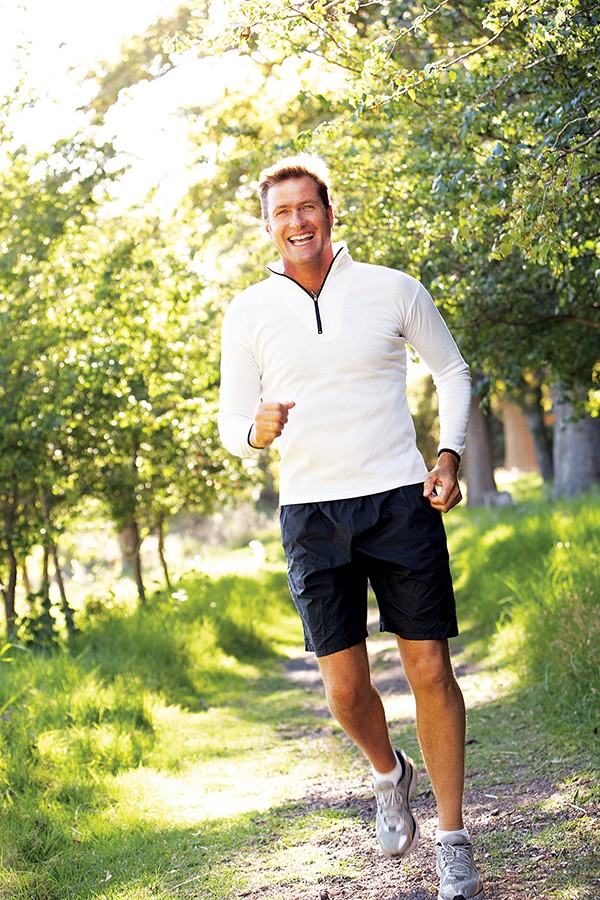About a year ago, after I turned 46, I began feeling a pain in my left calf. At first, it bothered me only at night, but the pain began to increase in frequency and intensity.
One Saturday morning, as I was leading a group of clients out for a run, my left leg gave out completely. I stumbled a little, only to have its use immediately return. I was shaken up enough to finally surrender my ego and pay a visit to a chiropractor. The X-rays they showed me that day were a bit startling. It was obvious that my spine was a mess, and that mess was starting to affect my mobility. I have been hard on my body over the years, and until my leg started giving out, I’d been training as if I were still 25. But a non-functioning leg and some cringe-worthy X-rays were proof: I was getting older.
Obviously, as we age, our bodies change, but that doesn’t mean that we should spend life after 40 plodding along doing steady-state cardio (jogging, cycling, etc.), never pushing ourselves to perform at a higher athletic level.
That said, getting older comes with some realities, so we want to make sure that as we push ourselves to be more athletic, we do it safely. Three components of fitness that decline as we age are strength, endurance, and agility. With just a little bit of focused effort, we can keep those areas sharper for decades.
STRENGTH: As we age, our muscle mass decreases. This is called sarcopenia. Living a sedentary lifestyle can cause us to lose up to 10 ounces of skeletal muscle a year. Some studies show that we can lose up to 30 percent of our muscle mass between the ages of 50 and 70.
Lifting weights is beneficial for a number of reasons. The muscle fibers needed to generate enough force to lift something heavy degenerate more rapidly than the ones used for slow, steady endurance work. So even if we jog 25 miles a week, we still may have muscles that are atrophying.
The good news is that age-induced sarcopenia is reversible. Just hit the weights. If you aren’t sure how to get started, do a little research on your own, hire a trainer, or join a group class.
Lastly, don’t worry about “getting big” (I hear this frequently used as an excuse to not lift). Two days a week of intentional weightlifting is not enough to get you looking like Arnold.
 Monkey Business Images | Dreamstime.com
Monkey Business Images | Dreamstime.com
ENDURANCE: Endurance training is simply engaging in any exercise that stresses our joints and muscles over a period of time and requires aerobic effort as opposed to anaerobic. This means endurance work requires a steady supply of oxygen to keep our body performing the way we want it to. The maximum rate your body can get oxygen into your blood and deliver it to your muscles so they can contract (work) is known as your max vO2.
Our max vO2 determines our stamina and can decrease by as much as 10 percent per decade. Obviously this decrease can have profound effects on our endurance levels. The irony is that just increasing our cardio activity isn’t enough to increase our max vO2. We need to mix our training up to increase our endurance. Don’t hesitate to lift weights and then hit the treadmill or track on the same day. Taxing our bodies aerobically and anaerobically in the same workout will lead to faster gains in endurance and stamina.
AGILITY: Agility is the ability to stop, speed up, or change direction without losing control of our body. This section is also about core strength, as our core is what keeps the rest of our body from tumbling over when our feet suddenly have to stop moving. Life is full of potential stumbling hazards like slippery floors, cracks in the sidewalk, and steps we might not have noticed were there. By strengthening our core through exercises like push-ups, planks, and almost any correctly performed weight-lifting exercise, we will reduce our chances of face planting.
Sometimes just stopping in our tracks isn’t enough though. We may need to suddenly leap over a puddle or maybe change direction quickly to avoid stepping on something. Our ability to move our feet quickly while maintaining control over our hips and torso can be improved by incorporating directional change drills into our training. “Directional change drills” is just a fancy way of saying go one way quickly and then change direction without losing time or falling down. Agility ladders are a fantastic way to become more agile. They are also inexpensive and easy to store.
Mark Akin is a personal trainer and co-owner of Envision Fitness. Contact him at Mark@envisionmemphis.com